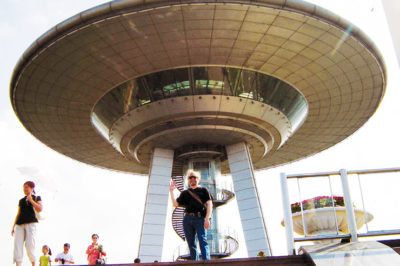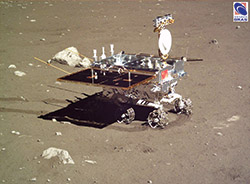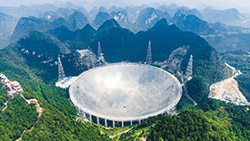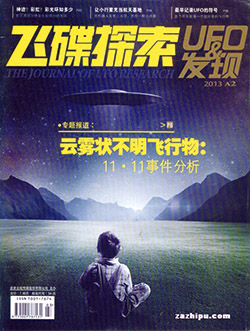From New Dawn Special Issue Vol 14 No 1 (Jan 2020)
“The universe is an ocean, the Moon is the Diaoyu Islands, Mars is Huangyan Island. If we don’t go there now even though we’re capable of doing so, then we will be blamed by our descendants. If others go there, then they will take over, and you won’t be able to go even if you want to. This is reason enough.”
Ye Peijian, a Chinese aerospace veteran and head of the Chinese lunar exploration programme, speaking at the 2017 Chinese Communist Party’s (CCP) annual plenary sessions in Beijing, was explaining why China was going to the Moon. Both Diaoyu and Huangyan are contested localities in regions that China regards as Chinese territory. The message couldn’t be more explicit. China going to the Moon and Mars is not just about scientific achievement or national pride – it’s also about forging Chinese power in the celestial empire of beyond.
The successful Chang’e 4 lander and Yutu 2 rover landing and deployment on the far side of the Moon on 3 January 2019 were both firsts. In January 2020, the China National Space Administration and the Chinese Academy of Sciences released data collected by the lander and rover acquired via a dedicated Chinese communications satellite positioned beyond the far side of the Moon.
US President Trump’s citing of “space threats” and mandating the Pentagon to establish the US Space Force had been anticipated and already developed by the CCP’s People’s Liberation Army (PLA), in a restructuring of Chinese military intelligence. Namely, the PLA Strategic Support Force (SSF – Zhanlue Zhiyuan Budui), which focuses on space, psychological, cyber and electronic warfare, under the direction of General Gao Jin, including the Aerospace Reconnaissance Bureau (tianjun bu).
A document published by the State Council in Beijing in 2015 declared: “Outer space has become the new commanding heights in international strategic competition. Countries concerned are developing their space forces and instruments, and the first signs of weaponisation of outer space have appeared.”
On the back of the paperback edition (2016) of Tom DeLonge & A.J. Hartley’s ‘Sekret Machines’ fictional trilogy Book 1: Chasing Shadows, which is about “alien” threats, former US Major General Michael J. Carey, special assistant to the Commander, Air Force Space Command, gave an endorsement in similar terms to the 2015 Beijing State Council declaration, namely, “Our military leaders have been saying space is a contested environment for years now, perhaps we should believe them!”
Time will tell if it’s more than only Earth-spawned military war zones at play here, but there seems to be a lot of data nudging us towards what seems an ‘alien’ take: It’s not from around here, mate.
The March to First Contact
China has even been leading the march to ‘first contact’ in more traditional scientific ways with radio telescope astronomy and its massive observatory dish in China’s Karst mountain region in the Dawodang depression, Pingtang County, Guizhou, southwest China. Formally called the Five-Hundred-Metre Aperture Spherical Radio Telescope (“FAST”), and nicknamed Tianyan or “Eye of the Sky/Heaven,” the dish has been dedicated to detecting interstellar communication signals.
Chinese Ufologists associate Guiyang, Guizhou province with the 1 December 1994 mini ‘Tunguska’-like event in the Duxi forest farm. This was a destructive UFO presence observed by local residents as a strong flaming light with an associated train-like rumbling noise. While some roofs were damaged, most of the destruction happened to 160 square metres of forest in which trees were broken off at the same height. This may have an association with an ‘airburst’ related to an astronomical event, but Chinese researchers argue for an alien-related UFO event.
In that same year – 1994 – the best-known alien abduction in China took place. Meng Zhao Guo, a young tree farmer from Wuchang near Harbin in Heilongjiang province, and two other farmworkers working at Red Flag logging camp saw something unusual on nearby Mount Phoenix. The complex and bizarre encounter that followed involved Meng being hit by a beam of light, as well as allegedly experiencing an abduction and a sexual encounter with a female alien.
Like so many of the worldwide cases of alien abduction, Meng Zhao Guo’s story is essentially just that – a story – and a bizarre one at that. In China, I was able to have extensive discussions with the principal researcher of the case, Professor Chen Gongfu.
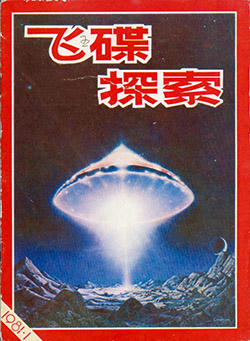
Another Alien Abduction Case
While visiting China in 2005, I obtained detailed information on a particularly interesting abduction case. Zhang Jingping of the World Chinese UFO Association had investigated the case which had a ‘forensic’ twist.
In December 1999, Cao Gong, a middle-aged man from Beijing, claimed to have been abducted by aliens and flown to Qinhuangdao in their UFO. “They looked like humans but had large hands and were very pale,” Cao told investigators. He said he had met a Chinese girl in the flying saucer.
Zhang’s investigation began in April 2000. The first step was hypnosis by a famous psychologist from Suzhou. He brought Cao to the Beijing Bureau of Public Security for a lie detection test. “He passed the test,” says Zhang.
The Chinese girl in the flying saucer looked around 13 years old. “The aliens cured her disease in the flying saucer,” Cao claimed. In order to find the girl, Zhang brought Cao to the Tangshan Bureau of Public Security in July 2000. “The policemen made up a computer image photo-fit of the girl’s face according to Cao’s description,” says Zhang.
In November 2002, Zhang led a group of students from Beihang University (previously known as Beijing University of Aeronautics and Astronautics) on a trip to Qinhuangdao in search of the mysterious girl.
“There was only a narrow glimmer of hope of finding the girl with only a computer image of her,” says Zhang.
They arrived in Qinglong County to the north of Qinhuangdao and began their blind search among the county’s 400,000 population.
“Amazingly, we found a clue on the second day of our search. An old man in the county recognised the girl in our picture,” says Zhang. They found the girl soon after that. She was 15 years old. Zhang brought her back to Beijing to meet Cao Gong. She was identified by Cao as the girl he had seen in the UFO.
Fortunately, while in China, I was able to discuss this fascinating case in detail with Zhang Jingping and other researchers, and also talk to Cao Gong himself. Apart from the “healing” aspects, it also includes other aspects of particular interest such as the apparent use of “solid light.” (See my article ‘UFOs & the Solid Light Enigma’ in New Dawn Special Issue V13N1.)
Chinese Ufology
I attended the 2005 World UFO Conference in Dalian, China, which provided me with a good opportunity to witness various manifestations of Chinese Ufology.
I was drawn to the event to further my understanding of UFO research activity in China. I was able to conduct a number of interviews and meet with key researchers and identities such as Professor Sun Shili, Zhang Jingping, Professor Ling Huan Ma (a very helpful Beijing based ‘UFO learner’), and Professor Chen Gongfu. Efforts to develop a World UFO Federation were spearheaded by the energetic Jan Fan (who I met in Dalian) of the Dalian UFO Research Association.
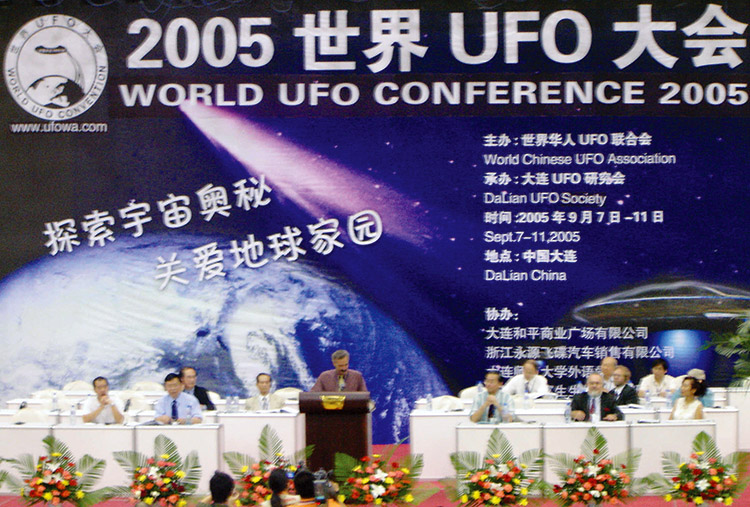
An indirect outgrowth of these efforts was Moon Fong’s Hong Kong UFO group organisation of the 2011 International UFO Conference which featured the major mainland Chinese UFO researchers who I extensively interviewed at the 2005 Dalian UFO Conference – Sun Shi Li, Professor Chen Gongfu and Zhang Jingping.
Lost in Translation?
There’s scant information on China’s UFO organisations, so an item in the South China Morning Post (SCMP) online edition of 22 December 2017 by Liu Zhen caught my eye. The headline ran: “Is anyone out there? The days when UFO fever gripped China: Stories about aliens and flying saucers once grabbed the public imagination in China but hardly generate interest now.”
A reference to my friend Zhang Jingping and the journalist’s take that he was “one of the few people on the mainland still interested in the subject” was such a huge disconnect from the reality I know of.
The SCMP story clearly got kickstarted due to the revelations on the secret Pentagon UFO program reported by The New York Times a few days earlier. It does capture some of the history of Chinese Ufology, but its suggestion that China’s “UFO fever” is a thing of the past seems out of touch with what’s going on.
Here are extracts from the SCMP story:
“Stories about aliens and flying saucers once grabbed the public imagination in China but hardly generate interest now.
“The national conversation about UFOs took off in China after 1978, with the revival of science and technology, an area that had been neglected during Mao Zedong’s Cultural Revolution. At the same time restrictions on the media loosened in China, and new science journals and periodicals launched across the country.
“But Qi Lian, editor-in-chief of The Journal of UFO Research, said her publication was the first of its kind in the country and really put the topic on the map.
“Back then the general public did not have access to scientific knowledge, and there were many myths surrounding subjects such as physics,” Qi said.
“By the early 1990s, the Lanzhou-based magazine had a circulation of more than 300,000 per issue, with the readership ranging from top scientists and civil servants to senior citizens and schoolchildren.
“The enthusiasm for all things extraterrestrial was shared by Spanish translator and former diplomat Sun Shili. Sun had long been interested in aliens and translated Sacerdotes o cosmonautas? (Priests or Cosmonauts?) into Chinese. The book was written by his friend Andreas Faber-Kaiser in 1971, and after the translation came out, Sun was soon regarded as an expert on the subject.
“That book is a summary of more than 300 books in the world about UFOs, and it was one of the first few on the topic available to intellectuals in China,” Sun said. “The very act of translating it probably made me one of the most knowledgeable UFO experts in China.”
“Sun went on to co-found China’s first UFO association in 1979, and served as an adviser, before becoming chairman a few years later. By 1988, the China UFO Association had grown to include 50,000 members, and became affiliated to the China Qigong Science Research Association.
“But the partnership between the qigong and UFO associations ended nine years later due to a controversy over whether qigong was a pseudoscience.
“Meanwhile, scores of provinces and cities on the mainland formed their own UFO organisations registered with local science and technology administrations.
“Zhang Jingping, an advertising company owner and a keen UFO hobbyist, dates his obsession with aliens back to the 1990s when he was in his early 20s. Zhang has travelled the country, interviewing people about their claims of extraterrestrial encounters. In some cases, he has hypnotised his subjects to get at the truth. The passion has taken him to the ends of the country, including Heilongjiang province, where a man claimed to have had a child with a female extraterrestrial. The man offered a meteorite as proof of his experience, Zhang said.
“I spend a lot of my own money to travel and investigate claims of alien sightings in China, purely out of personal interest,” he said.
“But Zhang is one of the few people on the mainland still interested in the subject.”
The SCMP story of December 2017 offered up a picture of Chinese UFO interest in its twilight years, but the opposite seems the case.
In July 2018 there was a US Roswell UFO Alien Civilisation Theme Exhibition in Chongqing, China with a Walmart connection! Jan Fan attended, promoting the World Chinese UFO Federation. In his opening speech, he said: “Welcome guests from all over the world. So, does UFO really exist? Are there really aliens? For thousands of years, these problems have been lingering in everyone’s heart… The facts will be used to answer everyone’s confusion.”
Researcher and writer Donald Schmidt, who was a special investigator for the late Dr J. Allen Hynek, also attended to discuss Roswell and UFO research. Chinese UFO research pioneer Sun Shili was also present. Filmmaker James Fox (UFOs: 50 Years of Denial?) was also on hand. On his blog he reported that he got a lot of UFO “gold” from his China visit. James interviewed my friend Zhang Jingping.
Zhang investigated an incident he refers to as the 1997 Datong “UFO crash” in which two “aliens” were allegedly present. Zhang interviewed an ex-military source, a young soldier who served three years in the third battalion of the Datong military training division. Zhang shared some details of his investigation with me, and I await with interest possible further developments. At this stage, the 1997 Datong account seems an intriguing story derived from a single witness.
The momentum of the Chongqing event led to a Moscow conference – Chinese ufology in Russia – which was attended by a few Western researchers including Gary Heseltine, editor and publisher of UFO Truth. The conference sought to progress a world coalition on ET Contact. I was asked to be the Australian representative but declined as the organisers asked for a declaration of belief in ET Contact. I’ve been advised that the conference objectives and plans were not fully delivered by the Chinese delegates, and it seems the initiative is now left to Western delegates to progress. Maybe that might change with further developments.
All these developments suggest to me that the South China Morning Post article was itself “lost in translation.” The UFO question in China seems to be ongoing and full of possibilities.
© New Dawn Magazine and the respective author.
For our reproduction notice, click here.

